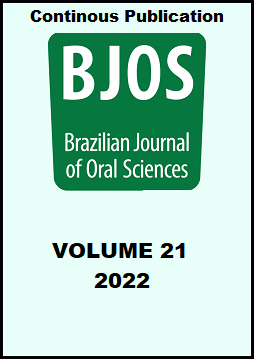Abstract
Aim: This study aimed to evaluate the decision-making by patients to replace temporary restorations with permanent restorations after endodontic treatment and to verify the associated factors and evaluate the quality/integrity of the temporary restorative material within one month. Methods: This is a cross-sectional study using non-probabilistic sampling which analyzed patients after one month of endodontic treatment. The self-administered questionnaire contained sociodemographic, treatment decision-making and endodontic treatment questions. The restoration present in the mouth was evaluated in the clinical oral examination. The Poisson Regression test was used to verify the prevalence ratio. Results: The prevalence failure to perform permanent restorations was 61.1% of patients, and 42.7% reported not having adhered. The reasons are lack of time and not knowing the importance of replacing the restoration with a definitive one. The glass ionomer temporary restorative frequency was higher among those who chose not to replace the temporary restoration with a permanent one (PR=5.19; 95%CI 2.10-12.33). In addition, there was an association between the quality of the restorative material and the type of material, and the best clinical quality of the restoration was statistically associated with glass ionomer and composite resin. Conclusions: The findings show the importance of guidance by the dental surgeon in helping patients decide to replace their temporary restoration.
References
Siqueira JF Jr. A etiology of root canal treatment failure: why well-treated teeth can fail. Int Endod J. 2001 Jan;34(1):1-10. doi: 10.1046/j.1365-2591.2001.00396.x.
Ng YL, Mann V, Gulabivala K. Tooth survival following non-surgical root canal treatment: a systematic review of the literature. Int Endod J. 2010 Mar;43(3):171-89. doi: 10.1111/j.1365-2591.2009.01671.x.
Gillen BM, Looney SW, Gu LS, Loushine BA, Weller RN, Loushine RJ, et al. Impact of the quality of coronal restoration versus the quality of root canal fillings on success of root canal treatment: a systematic review and meta-analysis. J Endod. 2011 Jul;37(7):895-902. doi: 10.1016/j.joen.2011.04.002.
Sadaf D. Survival rates of endodontically treated teeth after placement of definitive coronal restoration: 8-year retrospective study. Ther Clin Risk Manag. 2020 Feb 21;16:125-31. doi: 10.2147/TCRM.S223233.
Shu X, Mai Q Q, Blatz M, Price R, Wang X D, Zhao K. Direct and indirect restorations for endodontically treated teeth: a systematic review and meta-analysis, IAAD 2017 Consensus Conference Paper. J Adhes Dent. 2018;20(3):183-94. doi: 10.3290/j.jad.a40762.
Deepak S, Nivedhitha MS. Comparison of coronal microleakage of three temporary restorative material using dye penetration methods. J Adv Pharm Educ Res. 2017;7(3):232-5.
Soares CJ, Rodrigues PM, Silva ALF, Santos-Filho PCF, Veríssimo C, Kim HC, et al. How biomechanics can affect the endodontic treated teeth and their restorative procedures? Braz Oral Res. 2018 Oct;32(suppl 1):e76. doi: 10.1590/1807-3107bor-2018.vol32.0076.
Jensen AL, Abbott PV, Castro Salgado J. Interim and temporary restoration of teeth during endodontic treatment. Aust Dent J. 2007 Mar;52(1 Suppl):S83-99. doi: 10.1111/j.1834-7819.2007.tb00528.x.
Mickeviciute E, Ivanauskiene E, Noreikiene V. In vitro color and roughness stability of different temporary restorative materials. Stomatologija. 2016;18(2):66-72.
Guler AU, Yilmaz F, Kulunk T, Guler E, Kurt S. Effects of different drinks on stainability of resin composite provisional restorative materials. J Prosthet Dent. 2005; 94(2):118-24. doi: 10.1016/j.prosdent.2005.05.004.
Han GS, Shim YS, Choi YR, Jang SO. Viscosity, micro-leakage, water solubility and absorption in a resin-based temporary filling material. Ind J Sci Technol. 2015; 8(25):1-5. doi: 10.17485/ijst/2015/v8i25/80262.
Hickel R, Peschke A, Tays M, Major I, Bayne S, Peters M, et al. FDI World Dental Federation: clinical criteria for the evaluation of direct and indirect restorations - update and clinical examples. Clin Oral Invest. 2010 Aug;14(4):349-66. doi: 10.1007/s00784-010-0432-8.
Laske M, Opdam NJ, Bronkhorst EM, Braspenning JC, Huysmans MC. Longevity of direct restorations in Dutch dental practices. Descriptive study out of a practice-based research network. J Dent. 2016 Mar;46:12-7. doi: 10.1016/j.jdent.2016.01.002.
Lynch CD, Burke FM, Ní Ríordáin R, Hannigan A. The influence of coronal restoration type on the survival of endodontically treated teeth. Eur J Prosthodont Restor Dent. 2004 Dec;12(4):171-6.
Morgano SM, Rodrigues AH, Sabrosa CE. Restoration of endodontically treated teeth. Dent Clin North Am. 2004 Apr;48(2):vi, 397-416. doi: 10.1016/j.cden.2003.12.011.
Balkaya H, Topçuoğlu HS, Demirbuga S. The effect of different cavity designs and temporary filling materials on the fracture resistance of upper premolars. J Endod. 2019 May;45(5):628-33. doi: 10.1016/j.joen.2019.01.010.
Kameyama A, Saito A, Haruyama A, Komada T, Sugiyama S, Takahashi T, et al. Marginal Leakage of Endodontic Temporary Restorative Materials around Access Cavities Prepared with Pre-Endodontic Composite Build-Up: An In Vitro Study. Materials (Basel). 2020 Apr;13(7):1700. doi: 10.3390/ma13071700.
Nagasiri R, Chitmongkolsuk S. Long-term survival of endodontically treated molars without crown coverage: A retrospective cohort study. J Prosthet Dent. 2005 Feb;93(2):164-70. doi: 10.1016/j.prosdent.2004.11.001.
Stenhagen S, Skeie H, Bårdsen A, Laegreid T. Influence of the coronal restoration on the outcome of endodontically treated teeth. Acta Odontol Scand. 2020;78(2):81‐6. doi: 10.1080/00016357.2019.1640390.
Seiler KB. An evaluation of glass ionomer-based restorative materials as temporary restorations in endodontics. Gen Dent. 2006;54(1):33‐6.
Sivakumar JS, Suresh Kumar BN, Shyamala PV. Role of provisional restorations in endodontic therapy. J Pharm Bioallied Sci. 2013;5(Suppl 1): S120‐4. doi: 10.4103/0975-7406.113311.
Dowling AH, Fleming GJ. Are encapsulated anterior glass-ionomer restoratives better than their hand-mixed equivalents? J Dent. 2009 Feb;37(2):133-40. doi: 10.1016/j.jdent.2008.10.006.
Agrafioti A, Giannakoulas DG, Kournetas N, Grigoriou S, Kontakiotis EG. Different patterns of restoration provision between initial endodontic treatment and retreatment: a retrospective clinical study. Int J Prosthodont. 2017 Jul/Aug;30(4):354-6. doi: 10.11607/ijp.5121.
Ciftçi A, Vardarli DA, Sönmez IS. Coronal microleakage of four endodontic temporary restorative materials: an in vitro study. Oral Surg Oral Med Oral Pathol Oral Radiol Endod. 2009;108(4):e67-70. doi: 10.1016/j.tripleo.2009.05.015.
Pieper CM, Zanchi CH, Rodrigues-Junior SA, Moraes RR, Pontes LS, Bueno M. Sealing ability, water sorption, solubility and toothbrushing abrasion resistance of temporary filling materials. Int Endod J. 2009;42(10):893-9. doi: 10.1111/j.1365-2591.2009.01590.x.
Zmener O, Banegas G, Pameijer CH. Coronal microleakage of three temporary restorative materials: an in vitro study. J Endod. 2004;30(8):582-4. doi: 10.1097/01.don.0000121610.63000.f2.

This work is licensed under a Creative Commons Attribution 4.0 International License.
Copyright (c) 2021 Brazilian Journal of Oral Sciences


